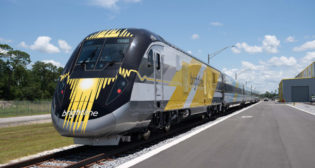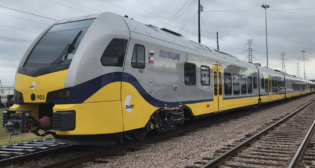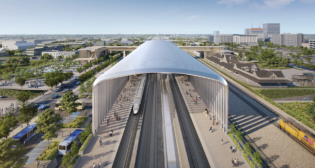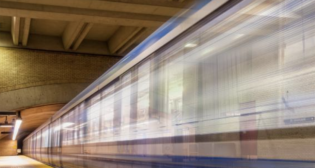
At APTA conference, rail transit at its best
Written by Lyndon HenryBig D, here I come! On June 2, some colleagues and I will be rumbling (literally) into Dallas to attend selected events in and around the 2012 Rail Transit Conference of the American Public Transportation Association (APTA).
 Dallas-area rail transit has come a long way from the rather sad days of my youth. Just to reminisce … I was born in a gorgeous classic stone Gothic-revival-style hospital with streetcars (and Texas Electric interurbans) clanging by on Bryan Street outside. I grew up riding those streetcars around Dallas (and the interurban at least once).
Dallas-area rail transit has come a long way from the rather sad days of my youth. Just to reminisce … I was born in a gorgeous classic stone Gothic-revival-style hospital with streetcars (and Texas Electric interurbans) clanging by on Bryan Street outside. I grew up riding those streetcars around Dallas (and the interurban at least once).
Heritage architecture was disparaged, not esteemed, in those days, so down came that venerable Gothic building, turrets and arched windows and all, to the wrecking ball, in favor of new Atomic and Space-Age-style structures … And out came the last remnants of Dallas’s once-impressive rail transit systems — a dense urban network of electric streetcars, plus electric interurbans that once stretched north to Denison, south to Waco and Corsicana, east to Terrell, and west to Fort Worth … not to speak of the busy passenger train traffic from and to everywhere from Dallas Union Terminal. Gone, all, until only a vestigial Amtrak service remained.
Neither historic architecture nor rail transit was considered of much value in that era. Ah, the Good Ol’ Days…
But the course of history underwent a dramatic reversal in about the mid-1970s, as interest in reinstalling rail transit began to revive. After Dallas civic leaders and planners flirted briefly with notions of monorails and subways, plans began to gel for a more affordable and suitably sized light rail transit (LRT) technology (interest in which, so I’ve been told, my own proposal at the time for LRT in Austin helped kindle).
In 1996, those plans were fulfilled in the opening of the first 11.2 miles of the Dallas Area Rapid Transit (DART) LRT system, preceded just a few months earlier by the opening of the Trinity Railway Express regional passenger rail (“commuter”) line over the 40-odd miles between Dallas Union Station (as it’s now known) and downtown Fort Worth.
I was there for the DART opening, and I have to say that seeing railcars (such as pictured above) running through downtown Dallas again after, after nearly four decades, was, well, mind-blowing.
Now, of course, it’s commonplace, and multiple interurban-like routes totaling 72 miles, with 55 stations, now zip through downtown, with most recently reported ridership averaging more than 83,000 on an average weekday. The latest route is the Green Line, added in 2009, running 28 miles with 20 stations from Carrollton on the northwest, through the Medical District and downtown, to East Dallas, Fair Park, and Pleasant Grove on the southeast. For more, see: Dallas: First Segment of Green Line Light Rail Extension Opens.
The TRE, gradually upgraded, now carries ridership averaging more than 8,000 per weekday.
But there’s more! Streetcars—real clang-clang-clang electric streetcars — have been making a comeback too. First, there was the heritage McKinney Avenue streetcar, started by a nonprofit group and serving an upscale area just north of downtown (and helping to stimulate the neighborhood’s renaissance). That’s been upgraded, extended, and adopted by DART, with a link to DART’s Red and Blue lines at Cityplace.
Now (helped by a federal economic recovery grant) DART’s also installing a modern-style, 1.6-mile streetcar line from Union Station, across the wide Trinity River flood plain, to Oak Cliff.
And a whole other rail transit system is now rolling in exurban Denton County, north of Dallas. The Denton County Transportation Authority’s A-train, opened in June 2011 and operating diesel multiple-unit trains (DMUs), is averaging about 1,600 passenger-trips per weekday over its 21-mile line between the small city of Denton and a connection with DART’s Green Line at Carrollton. For more, see: Denton, Texas Rolls Out Its A-train Regional Passenger Rail Service.
All in all, it will be a pleasure to inspect and ride some of these new lines in the midst of what today is surely one of the most impressive examples of rail transit revival in the country.



